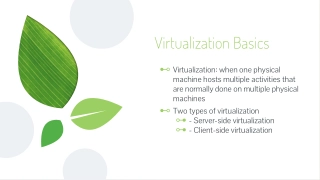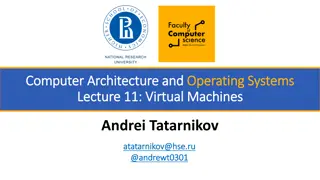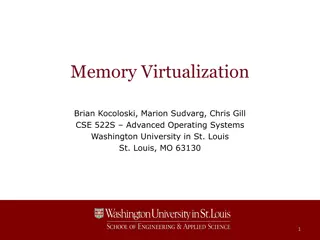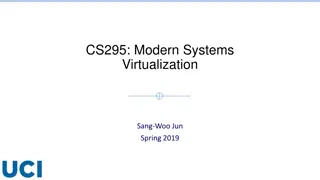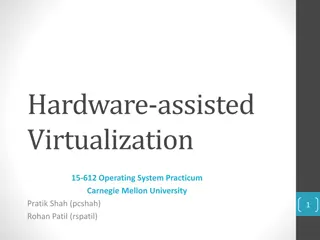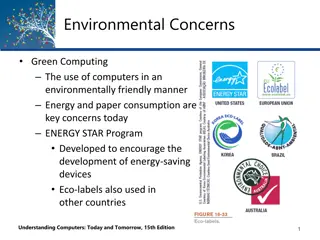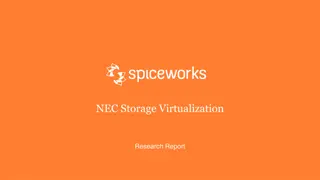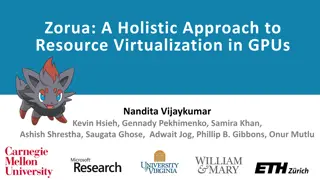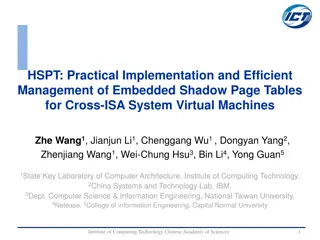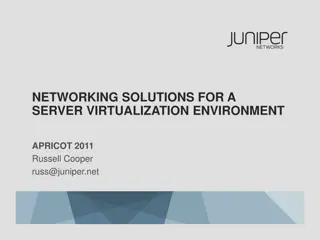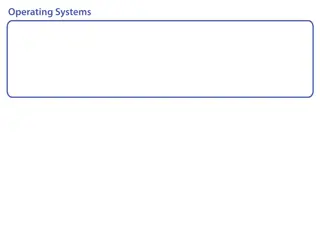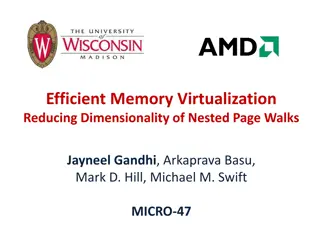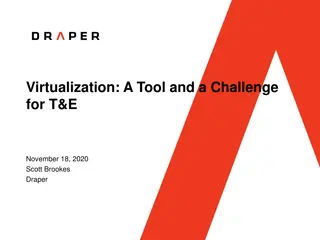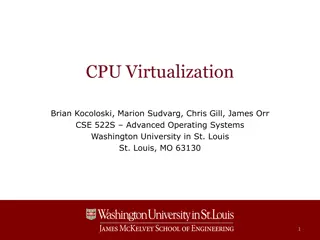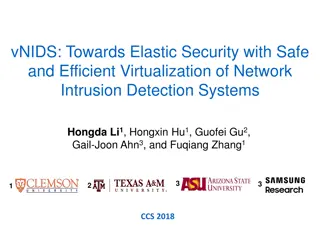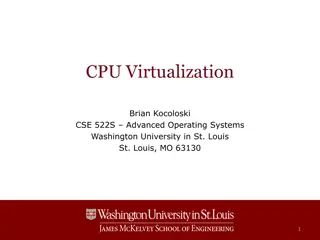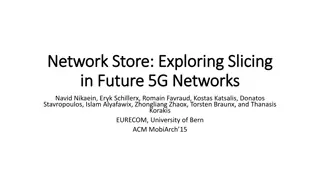Introduction to Virtualization: Concepts and Evolution
Virtualization allows running multiple operating systems on a single physical system, optimizing hardware usage and enhancing flexibility. It can be achieved through different architectures like Hosted and Bare-Metal, with examples including VMware and Xen. The history of virtualization traces back to the 1960s, experiencing waves of popularity due to advancements in hardware and the rise of cloud computing. Understanding its formal requirements and platforms is essential for efficient system management.
Download Presentation

Please find below an Image/Link to download the presentation.
The content on the website is provided AS IS for your information and personal use only. It may not be sold, licensed, or shared on other websites without obtaining consent from the author. Download presentation by click this link. If you encounter any issues during the download, it is possible that the publisher has removed the file from their server.
E N D
Presentation Transcript
CS6456: Graduate Operating Systems Brad Campbell bradjc@virginia.edu https://www.cs.virginia.edu/~bjc8c/class/cs6456-f19/
What is virtualization? Virtualization is the ability to run multiple operating systems on a single physical system and share the underlying hardware resources1 Allows one computer to provide the appearance of many computers. Goals: Provide flexibility for users Amortize hardware costs Isolate completely separate users 1VMWare white paper, Virtualization Overview
Formal Requirements for Virtualizable Third Generation Architectures First, the VMM provides an environment for programs which is essentially identical with the original machine; second, programs run in this environment show at worst only minor decreases in speed; and last, the VMM is in complete control of system resources.
Native and Hosted VM Systems Guest Guest Applications Applications Guest Applications Guest OS Guest OS Applications Nonprivileged modes Guest OS VMM VMM Privileged modes OS VMM Host OS Host OS Hardware Hardware Hardware Hardware Traditional Uniprocessor System Native VM System User-mode Hosted VM System Dual-mode Hosted VM System
VMM Platform Types Hosted Architecture Install as application on existing x86 host OS, e.g. Windows, Linux, OS X Small context-switching driver Leverage host I/O stack and resource management Examples: VMware Player/Workstation/Server, Microsoft Virtual PC/Server, Parallels Desktop Bare-Metal Architecture Hypervisor installs directly on hardware Acknowledged as preferred architecture for high-end servers Examples: VMware ESX Server, Xen, Microsoft Viridian (2008)
Virtualization: rejuvenation 1960 s: first track of virtualization Time and resource sharing on expensive mainframes IBM VM/370 Late 1970s and early 1980s: became unpopular Cheap hardware and multiprocessing OS Late 1990s: became popular again Wide variety of OS and hardware configurations VMWare Since 2000: hot and important Cloud computing Docker containers
IBM VM/370 Robert Jay Creasy (1939-2005) Project leader of the first full virtualization hypervisor: IBM CP-40, a core component in the VM system The first VM system: VM/370
IBM VM/370 Specialized VM subsystem (RSCS, RACF, GCS) Conversatio nal Monitor System (CMS) Mainstream OS (MVS, DOS/VSE etc.) Another copy of VM Virtual machines Hypervisor Control Program (CP) System/370 Hardware
IBM VM/370 Technology: trap-and-emulate Problem Application Kernel Privileged Trap Emulate CP
Virtualization on x86 architecture Challenges Correctness: not all privileged instructions produce traps! Example: popf popf does different things in kernel mode vs. user mode Performance: System calls: traps in both enter and exit (10X) I/O performance: high CPU overhead Virtual memory: no software-controlled TLB
Virtualization on x86 architecture Solutions: Dynamic binary translation & shadow page table Para-virtualization (Xen) Hardware extension
Dynamic binary translation Idea: intercept privileged instructions by changing the binary Cannot patch the guest kernel directly (would be visible to guests) Solution: make a copy, change it, and execute it from there Use a cache to improve the performance
Binary translation Directly execute unprivileged guest application code Will run at full speed until it traps, we get an interrupt, etc. Binary translate all guest kernel code, run it unprivileged Since x86 has non-virtualizable instructions, proactively transfer control to the VMM (no need for traps) Safe instructions are emitted without change For unsafe instructions, emit a controlled emulation sequence VMM translation cache for good performance
How does VMWare do this? Binary input is x86 hex , not source Dynamic interleave translation and execution On Demand translate only what about to execute (lazy) System Level makes no assumptions about guest code Subsetting full x86 to safe subset Adaptive adjust translations based on guest behavior
Convert unsafe operations and cache them Input: BB 55 ff 33 c7 03 ... Each Translator Invocation Consume a basic block (BB) Produce a compiled code fragment (CCF) Store CCF in Translation Cache Future reuse Capture working set of guest kernel Amortize translation costs Not patching in place translator Output: CCF 55 ff 33 c7 03 ...
Dynamic binary translation Pros: Make x86 virtualizable Can reduce traps Cons: Overhead Hard to improve system calls, I/O operations Hard to handle complex code
Shadow page table Guest page table Shadow page table
Shadow page table Pros: Transparent to guest VMs Good performance when working set is stable Cons: Big overhead of keeping two page tables consistent Introducing more issues: hidden fault, double paging
Para-virtualization Full vs. para virtualization
Xen and the art of virtualization SOSP 03 Very high impact (data collected in 2013) Citation count in Google scholar 5153 8807 6000 5000 4000 3090 2116 3000 2286 1796 1413 2000 1229 1222 1219 1093 461 1000 0
Overview of the Xen approach Support for unmodified application binaries (but not OS) Keep Application Binary Interface (ABI) Modify guest OS to be aware of virtualization Get around issues of x86 architecture Better performance Keep hypervisor as small as possible Device driver is in Dom0
Virtualization on x86 architecture Challenges Correctness: not all privileged instructions produce traps! Example: popf Performance: System calls: traps in both enter and exit (10X) I/O performance: high CPU overhead Virtual memory: no software-controlled TLB
CPU virtualization Protection Xen in ring0, guest kernel in ring1 Privileged instructions are replaced with hypercalls Exception and system calls Guest OS registers handles validated by Xen Allowing direct system call from app into guest OS Page fault: redirected by Xen
Memory virtualization Xen exists in a 64MB section at the top of every address space Guest sees real physical address Guest kernels are responsible for allocating and managing the hardware page tables. After registering the page table to Xen, all subsequent updates must be validated.
I/O virtualization Shared-memory, asynchronous buffer descriptor rings
Conclusion x86 architecture makes virtualization challenging Full virtualization unmodified guest OS; good isolation Performance issue (especially I/O) Para virtualization: Better performance (potentially) Need to update guest kernel Full and para virtualization will keep evolving together
Corollary: How often do we lose our audience? My tip: put the point of the slide directly in the title Evaluation vs. Xen is 1.1x to 3x more performant than VMWare
Instead: Leverage hardware support First generation - processor Second generation - memory Third generation I/O device
IA Protection Rings (CPL) CPU Privilege Level (CPL) Actually, IA has four protection levels, not two (kernel/user). IA/X86 rings (CPL) Ring 0 Kernel mode (most privileged) Ring 3 User mode Ring 1 & 2 Other Linux only uses 0 and 3. Kernel vs. user mode Pre-VT Xen modified to run the guest OS kernel to Ring 1: reserve Ring 0 for hypervisor. Increasing Privilege Level Ring 0 Ring 1 Ring 2 Ring 3 [Fischbach]
Why arent (IA) rings good enough? VM CPL 3 Increasing Privilege Level CPL 1 guest kernel Ring 0 CPL 0 hypervisor Ring 1 Ring 2 ??? Ring 3
A short list of pre-VT problems Early IA hypervisors (VMware, Xen) had to emulate various machine behaviors and generally bend over backwards. IA32 page protection does not distinguish CPL 0-2. Segment-grained memory protection only. Ring aliasing: some IA instructions expose CPL to guest! Or fail silently Syscalls don t work properly and require emulation. sysenter always transitions to CPL 0. (D oh!) sysexit faults if the core is not in CPL 0. Interrupts don t work properly and require emulation. Interrupt disable/enable reserved to CPL0.
First generation: Intel VT-x & AMD SVM Eliminating the need of binary translation or modifying OSes Host mode Guest mode Ring3 Ring3 VMRUN Ring2 Ring2 Ring1 Ring1 VMEXIT Ring0 Ring0
VT in a Nutshell New VM mode bit Orthogonal to CPL (e.g., kernel/user mode) If VM mode is off host mode Machine looks just like it always did ( VMX root ) If VM bit is on guest mode Machine is running a guest VM: VMX non-root mode Machine looks just like it always did to the guest, BUT: Various events trigger gated entry to hypervisor (in VMX root) A virtualization intercept : exit VM mode to VMM (VM Exit) Hypervisor (VMM) can control which events cause intercepts Hypervisor can examine/manipulate guest VM state and return to VM (VM Entry)
CPU Virtualization With VT-x Virtual Machines (VMs) Two new VT-x operating modes Less-privileged mode (VMX non-root) for guest OSes More-privileged mode (VMX root) for VMM Two new transitions VM entry to non-root operation VM exit to root operation Apps Apps Ring 3 OS OS Ring 0 VM Exit VM Entry VMX Root VM Monitor (VMM) Execution controls determine when exits occur Access to privilege state, occurrence of exceptions, etc. Flexibility provided to minimize unwanted exits VM Control Structure (VMCS) controls VT-x operation Also holds guest and host state
Second generation: Intel EPT & AMD NPT Eliminating the need to shadow page table
Third generation: Intel VT-d & AMD IOMMU I/O device assignment VM owns real device DMA remapping Support address translation for DMA Interrupt remapping Routing device interrupt OSDI 12
Run App as a process in guest mode, and let it use all CPLs.
Hypervisor calls VT VMCALL operation (an instruction) voluntarily traps to hypervisor. Similar to SYSCALL to trap to kernel mode. Not needed for transparent virtualization: but Dune uses it to call the real kernel.
Memory& management& in& Dune& Configure& the& EPT& to& provide& process& memory& User& programs& can& then& directly& access& the& page& table& Dune& Process' Guest-Virtual& User& Page& Table& Kernel' Host-Virtual& Guest-Physical& Kernel& Page& Table& EPT& Host-Physical& (RAM)& 15&


